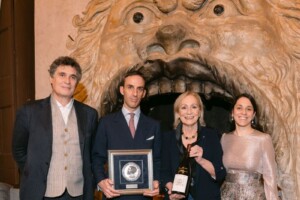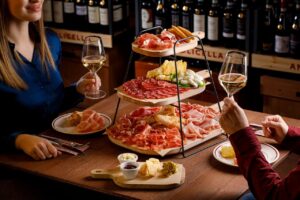Just like restoring art works protects a cultural heritage from being lost to the world, with the same desire to preserve and transmit past memory for new generations even in the wine world there is the possibility of giving new life and bringing back old vines to the vineyards. This wine culture operation will be better understood in years to come, but meanwhile it lets us expand and enrich the considerable wealth of varieties that is the “Italian vineyard”.
A small miracle then, that only the plant kingdom can guarantee, giving birth to new “children” from ancient fathers, of which more and more foreign and Italian wineries have understood or understand its importance, starting from Caprai in Umbria to Trentino through the recovered vineyards of San Leonardo Estate, or the centuries-old plants that have been given new life in the Irpinia fiefs of San Gregorio, the so-called “Monumental Vines” or “Patriarchs”, and they are also beginning think about it in the Montalcino terroir and in Angelo Gaja’s companies in Piedmont or Vittorio Moretti’s in Franciacorta. This operation is accomplished through a patient process of pruning and tree regeneration, put into practice with a precise method: the “Grape Preparers” Marco Simonit and Pier Paolo Sirch who, after more than 20 years of observation and experimentation in the vineyards of Europe, have developed a method of pruning that can significantly lengthen the life cycle and productivity of vineyards (narrated through images in an on line video today on YouTube).
They have brought back the ancient craft of the pruner who, like a surgeon decides the fate of lives, intervenes as non-invasively as possible on the health of the plant, which allows it to even double its age. This approach has become a school, thanks to the interest of important research centers and universities, and today is the “Italian Permanent School of Vine Pruning”, unique in its kind in Italy and on an international level. It is a mobile school and is operating in the major Italian wine regions.
The school will begin the 2011-2012 year from the San Felice farm in Tuscany and then make a stop in the wineries of the fief of San Gregorio, Bellavista and Bolla (GIV- Italian wines group), Enoteca Cormòns, University of Pollenzo, Libera Terra and the Institutes of Laimburg, San Michele sull' Adige and Conegliano. “Our operation starts from maximum attention to manual pruning which remains the only viable method to accommodate the physiology of the vine,” explains Marco Simonit.
“Then, our work is based on a modern reinterpretation of some now abandoned cultivation techniques, like the old ways of farming vineyards (tent, tree and so forth). A heritage that is now almost lost, and which points out the human inability to interact with the vine itself. This can be exemplified by the fact that modern viticulture has drastically reduced the space available to the vine,” Simonit points out.
“It is pretty obvious: a young tree does not occupy the same space as an old one. Neglecting this aspect over time has caused major imbalances leading up to the almost “normal” practice of early eradication of a vineyard. Knowing how to manage the old kind of vineyard with its particular geometry teaches us to work better in modern vineyards. Our main goal is to bring the old into the new: examples of the work we have already brought to an optimum level are Syrica in Campania, Tocai in Friuli, Nerello Mascalese in Sicily and Nebbiolo in Valtellina. After all, it is,” Simonit concludes, “restoration that avoids grubbing old vineyards. We would also be pleased to receive reports if there were similar cases in other parts of Italy. We are thinking about doing a similar operation in Montalcino in the future, but we haven’t started the project yet”.
To communicate the passion and the philosophy behind their work, the “Grape Preparers” have created a video-story that through evocative images of their work sites -the vineyards from northern to southern Italy- narrates in a many–voiced, clear and immediate language, including the voices of producers, experts and scholars, their fundamental philosophy of vineyard management based on a judicious mix of tradition and innovation. To explain what makes a wine unique and inimitable, first of all, is the health of the vine.
Focus - What is the “Italian Permanent School of Vine Pruning” The project of the Friulian technicians, Marco Simonit and Pier Paolo Sirch, to return longevity to vines has taken a new step forward with the foundation of the first “Italian Permanent School of Vine Pruning”. The school, which is unique not only in Italy but internationally as well, is a permanent training center with courses organized in partnership with leading research centers and universities (including the Experimental Institute of Laimburg in Alto Adige, the University of Gastronomic Sciences of Pollenzo and Slow Food in Piedmont, the Center for Teaching and Research in Viticulture and Enology of Cormòns, the Agricultural University of Udine in Friuli Venezia Giulia, the Enzo Morganti Center for Studies in Castelnuovo Berardenga in Tuscany, the Cervim-Research Center, Research and Development for the Mountain Viticulture in Val d’Aosta and the Franciacorta Terra Moretti Group) in the most representative regions of Italian winemaking excellence: Piedmont, Lombardy, Trentino Alto Adige, Friuli Venezia Giulia, Tuscany, Campania and Sicily. It is a mobile school and open to not only growers. The lessons are divided into two phases: 20 hours in the winter, with theoretical and practical interventions on the wood in the vineyard during pruning. 12 hours in the spring, regarding management of the vines.
Specifically, the Simonit & Sirch method is based on a respectful approach to the rhythms of nature and focused on a single plant, pruning only on young wood in order to safeguard the health of the vine. It is a “soft” technique that ensures a sustainable and balanced development of the plant, without the stress of intensive and immediate exploitation that today guides the process of mechanization and standardization of vineyards.
The goal of the School is to recover the ancient craft of pruning, which like a surgeon decides the fate of lives, intervenes as non-invasively as possible on the health of the plant, and allows it to even double its age: vines often get diseases because of a foolish approach to pruning that causes infections to spread very quickly in the wood. This implies an immediate assessment of the Italian vineyard, to safeguard the economic, historic and environmental landscape. Not only, it is also a significant savings for companies, there is a considerable reduction of costs in the vineyard with the decrease in hours of pruning (30 to 50%) and, especially, longer-life and healthier plants that give higher quality grapes and wine. A new ancient profession, then, that of the pruner, wrongly considered humble, that buys new dignity and opens interesting perspectives for young people in the Green Economy.
Highlights - 2011-2012: the “Italian Permanent School of Vine Pruning” starts in Tuscany
Tuscany was among the first centers of the “Italian Permanent School of Vine Pruning”. In 2009 the San Felice of Castelnuovo Berardenga (Siena) hosted the first experimental courses. Now that there are 10 centers, the collaboration between the Enzo Morganti Center for Studies and the “Grape Preparers” has become more intense.
On November 28, 29 and 30th, San Felice will kick off the third year courses, with a limited number of participants (maximum 35): 3 days for winter classes, and the next classes will follow in early spring 2012. In the 20 hours of lectures in winter, there will be theory (Basic Elements of the Physiology of the vine and pruning course) and practice in vineyards already pruned according to the Simonit & Sirch method (practical aspects of “soft” pruning referring to the two major phases- breeding and production of Guyot and Cordon). The 12 hours in spring will address, in theory and practice, vine management. Besides Tuscany, lessons will be held in 9 other locations, in collaboration with prestigious universities and research institutes linked to the world of the vine, interested in the Simonit & Sirch method: Enoteca Cormòns in Cormòns (Gorizia) in collaboration with the University of Udine - Department of Agriculture (1, 2 and 3 December); the winery of the Fief of San Gregorio in Sorbo Serpico (Avellino) in collaboration with “De Sanctis” Agricultural Institute of Avellino (12, 13 and 14 January 2012); the Professional School for the fruit-vegetable-vines and fruit culture (Fachshule) in Laimburg (Bolzano) in collaboration with Fachschule Laimburg, Experimental Research Institute and the Association of Alumni of Laimburg Alto Adige (1, 2 and 3 February 2012); the Bellavista winery in Erbusco (Brescia), in collaboration with the Terra Moretti Group (2, 3 and 4 February 2012); the University of Gastronomic Sciences in Pollenzo (CN) in collaboration with the University and Slow Food (dates to be confirmed); in San Giuseppe Jato (Palermo), Libera Terra (23, 24 and 25 February 2012); San Michele on the Adige (Trento) Agrarian Institute of San Michele all’Adige (February); in Conegliano Veneto (Treviso) Cirve to-Interdepartmental Centre for Research in Viticulture and Enology (February), and finally, in San Pietro in Cariano (Verona) in the historic Bolla cellars of Italian Wines Group (dates to be confirmed in January-February).
Info: www.simonitesirch.it
Copyright © 2000/2025
Contatti: info@winenews.it
Seguici anche su Twitter: @WineNewsIt
Seguici anche su Facebook: @winenewsit
Questo articolo è tratto dall'archivio di WineNews - Tutti i diritti riservati - Copyright © 2000/2025








































































































































































































